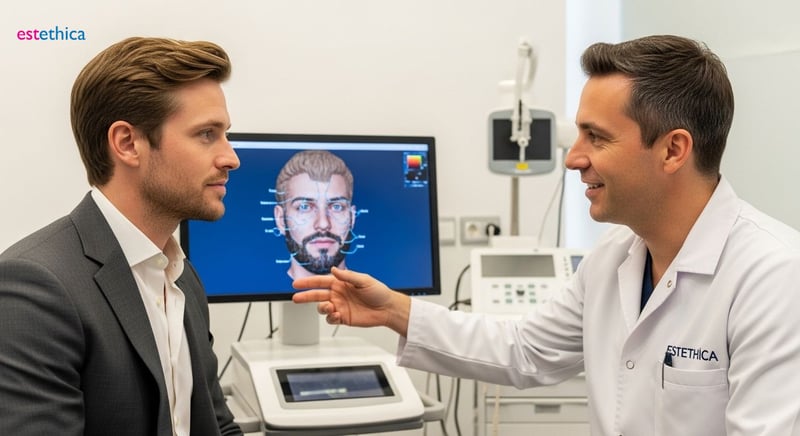Beard Restoration Revolution: Your Guide to Facial Hair Revival
Explore the complete guide to facial hair transplants and achieve the beard of your dreams.
Achieving the perfect beard is no longer a distant dream with the modern advancements in hair transplant technology. A facial hair transplant offers an effective solution for those struggling with patchy or uneven beard growth, providing results that are both permanent and natural-looking. In this comprehensive guide, we will explore the ins and outs of beard transplantation, from understanding if the procedure is right for you to the crucial details of FUE (Follicular Unit Extraction) techniques used in beard restoration. Whether you're looking for a fuller beard or wish to cover facial scars, a beard transplant might be your path to the perfect facial hair.
Facial Hair Growth Surgery: Is a Beard Transplant Right for You?
Determining Candidacy for a Beard Transplant
For many, sporting a full, thick beard is more than just a style choice; it's a matter of confidence. Beard transplants have become a go-to solution for men worldwide looking to enhance their facial hair. The ideal candidate is anyone with patchy or slow-growing facial hair. If you've struggled with achieving the beard style you desire naturally, you might be a good candidate for a facial hair transplant. It’s crucial to consult with a specialist to discuss your goals and any concerns you may have, ensuring the procedure aligns with your expectations. Beard transplants offer a permanent solution, utilizing advanced techniques to achieve natural-looking results. Consulting with a qualified surgeon will help clarify if a beard transplant is the right option for you.
Factors Influencing Your Decision
Choosing to undergo a beard transplant involves several considerations. The decision is influenced by the desire for a fuller beard, the ability to achieve a specific style, and the overall impact on one's self-esteem. Before considering a beard transplant, it's important to understand the procedure's potential benefits and limitations. A beard transplant can dramatically enhance facial aesthetics, providing a permanent solution for those seeking increased density and definition. The procedure involves transplanting hair follicles from a donor area to the face, resulting in natural-looking hair growth. Consulting with a specialist will provide a comprehensive understanding of what to expect, allowing for an informed decision.
- Desire for a Fuller Beard: Many men seek beard transplants to achieve a thicker, more complete beard.
- Achieving a Specific Style: Transplants allow for customized beard designs to match personal preferences.
- Boosting Self-Esteem: A fuller beard can significantly improve confidence and overall self-image.
Understanding these factors is essential in determining whether a beard transplant aligns with your personal goals and expectations.
- Initial Consultation: Discuss your beard goals and assess your candidacy with a specialist.
- Procedure Overview: Understand the steps involved in the transplant process and what to expect.
- Post-Operative Care: Learn about the recovery process and how to ensure optimal results.
By understanding these steps, you can better prepare for the beard transplant journey and ensure a successful outcome.

FUE Beard Transplant: The Gold Standard in Beard Restoration
Advantages of the FUE Technique for Beard Transplants
The FUE (Follicular Unit Extraction) technique has transformed beard transplants by offering a minimally invasive yet highly effective solution. Unlike older methods, FUE involves extracting individual hair follicles from a donor area, usually the back of the scalp, and carefully implanting them into the beard area. This approach results in minimal scarring and a faster recovery, making it a popular choice among both specialists and patients. The FUE technique’s precision and reduced invasiveness make it ideal for creating natural-looking results in beard restoration. The popularity of FUE has grown due to its ability to provide customized solutions with minimal downtime, allowing patients to quickly return to their daily routines with a fuller, more defined beard.
- Minimal Scarring: FUE leaves tiny, virtually undetectable scars in the donor area.
- Quicker Recovery: Patients experience a shorter recovery period compared to traditional methods.
- Natural-Looking Results: The precise extraction and implantation ensure a natural beard appearance.
These advantages make FUE the preferred technique for those seeking effective and aesthetically pleasing beard restoration.
What to Expect During the FUE Beard Transplant Procedure
The FUE beard transplant procedure involves several key steps, starting with the extraction of individual hair follicles from the donor area. These follicles are then meticulously prepared and implanted into the beard region, following a carefully designed pattern to ensure natural growth and density. The entire process is performed with precision to minimize trauma to the scalp and facial skin, promoting faster healing and optimal results. The artistic skill of the surgeon plays a crucial role in achieving a natural-looking beard that complements the patient's facial features. Proper post-operative care is essential to ensure the transplanted follicles take root and grow successfully, leading to a fuller, more defined beard over time. The FUE method’s focus on detail and patient comfort makes it a superior choice for beard restoration.
- Follicle Extraction: Individual hair follicles are carefully extracted from the donor area.
- Implantation: The extracted follicles are implanted into the beard area with precision.
- Post-Operative Care: Proper care is taken to ensure the transplanted follicles thrive.
Understanding these steps helps patients prepare for the procedure and ensures they achieve the best possible outcome.

Beard Transplant Before and After: What to Expect on Your Journey
Visual Transformation: Understanding the Change
The journey of a beard transplant is marked by a visible transformation, often documented through before and after photographs. These images highlight the contrast between the initial state—which may include patchiness or thin growth—and the post-transplant results, showcasing a fuller, more defined beard. Patients often report increased satisfaction with their appearance, noting a significant improvement in their facial aesthetics. The visual impact of a successful beard transplant can be profound, boosting confidence and enhancing overall self-image. Documented cases reveal that the density and uniformity achieved through the procedure contribute to a more masculine and aesthetically pleasing look. The transformation extends beyond mere appearance, positively influencing how individuals perceive themselves and are perceived by others.
- Enhanced Density: Post-transplant beards exhibit a significant increase in hair density.
- Improved Definition: The beard gains a more distinct and well-shaped appearance.
- Increased Confidence: Patients often experience a boost in self-esteem due to the aesthetic improvement.
These visual enhancements underscore the transformative potential of a beard transplant, offering a tangible improvement in facial aesthetics.
The Timeline: From Healing to Full Growth
Understanding the timeline of a beard transplant is crucial for setting realistic expectations. The initial healing phase typically lasts a few weeks, during which some of the transplanted hairs may shed—a normal part of the process. New growth begins within a few months, gradually increasing in density and fullness over the following year. Patience is key, as the final results may take up to twelve months to fully materialize. Regular follow-up appointments with the surgeon can help monitor progress and address any concerns. The gradual development of the beard allows for natural integration with existing facial hair, ensuring a seamless and authentic appearance. The transplant journey requires commitment and adherence to post-operative care instructions to optimize growth and achieve the desired outcome.
- Initial Healing: The first few weeks involve healing and potential shedding of transplanted hairs.
- Early Growth: New hair growth starts within a few months post-transplant.
- Final Results: Full beard growth and density are typically achieved within a year.
Adhering to this timeline and maintaining open communication with your surgeon will help ensure a successful and satisfying beard transplant experience.

Donor Hair for Beard Transplant: Ensuring Natural-Looking Results
Optimizing Donor Hair Selection for Natural Results
Selecting the right donor hair is crucial for achieving a natural-looking beard transplant. Hair from the back of the scalp is often preferred because it closely matches the texture and growth cycle of facial hair. This careful selection ensures that the transplanted beard blends seamlessly with existing hair, resulting in a more authentic appearance. The angle and direction of hair implantation are also vital, mimicking natural beard growth patterns. Skilled surgeons pay close attention to these details to create a beard that looks as natural as possible. The choice of donor hair significantly impacts the overall success and aesthetic outcome of the beard transplant procedure, making it a critical consideration for both the surgeon and the patient. Proper donor hair selection ensures the transplanted beard appears genuine and well-integrated.
- Texture Matching: Selecting hair with similar texture to facial hair.
- Growth Cycle: Choosing hair with a comparable growth rate to beard hair.
- Seamless Blend: Ensuring transplanted hair integrates naturally with existing facial hair.
These factors contribute to a more natural and aesthetically pleasing beard transplant result.
Factors Affecting Donor Hair Quality and Suitability
The quality and suitability of donor hair are influenced by several factors, including hair density, color, and overall health. High hair density in the donor area ensures an adequate supply of follicles for transplantation. Matching the color of the donor hair to the existing facial hair is essential for a uniform and natural look. Healthy donor hair follicles are more likely to thrive after transplantation, leading to better growth and density in the beard area. Surgeons carefully assess these factors to determine the best source of donor hair for each patient. A thorough evaluation of donor hair characteristics ensures the transplanted beard achieves the desired fullness and appearance. The health and characteristics of donor hair play a significant role in the success and longevity of a beard transplant.
- Density Assessment: Evaluating the hair density in the donor area.
- Color Matching: Ensuring the donor hair color matches the existing facial hair.
- Health Evaluation: Assessing the overall health and vitality of the donor hair follicles.
These steps help ensure the transplanted beard looks natural and maintains long-term growth.
FUE Beard Transplant: Minimally Invasive Technique for Natural-Looking Beard Restoration
Ensuring Natural Beard Growth Through Optimal Donor Hair Selection and Post-Operative Care
Frequently Asked Questions
Is a beard transplant a permanent solution for patchy facial hair?
What is FUE and why is it considered the gold standard for beard restoration?
What can I expect during the beard transplant before and after process?
Where does the donor hair come from for a beard transplant and how is it chosen?
How does a facial hair transplant differ from other hair restoration procedures?
Ready to discover your personalized path to aesthetic excellence and well-being with estethica's expert guidance?
📞 Schedule Your Free Consultation!